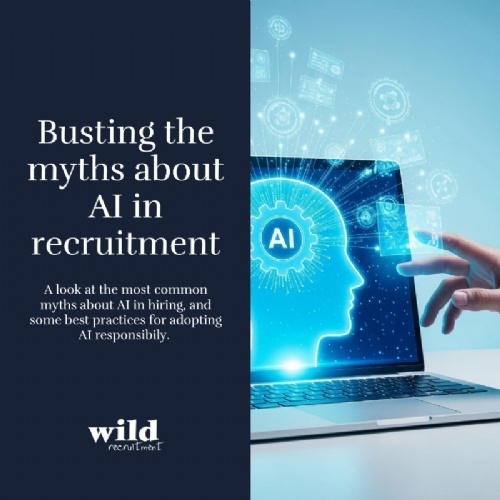Busting the myths about AI in recruitment

Recruitment is undergoing a significant shift as AI tools move from novelty to necessity. Today, 57% of recruitment professionals are experimenting with AI as part of the hiring process, and 11% have fully integrated these tools into their processes already.
But even as we race to adopt AI, doubts remain; will it cost people their jobs, deepen hiring bias, or take away the human touch? In this blog, we look at the most common myths around AI in hiring, and share some best practices for adopting AI responsibly.
Common myths
Myth 1: AI will replace human recruiters
AI supports, not substitutes, human recruiters and hiring managers. Think of it as another set of hands that automates repetitive tasks but leaves the task of relationship-building, hiring strategy and empathy towards candidates solely in human hands.
Myth 2: AI makes hiring 100% unbiased
AI reflects the data it is given, so while it can reduce bias in job descriptions and screening, if the data input is biased or based on out-dated hiring requirements then it will reflect that. Human oversight is still critical.
Myth 3: AI tools are complex and too expensive
Many AI tools are scalable, user-friendly and affordable. They can be used by individuals, or a part of a large Applicant Tracking System to various types of agencies or companies.
Myth 4: AI in recruitment is a passing trend
The use of AI as a tool has gone well past a passing trend; it is already embedded in many systems across recruitment and other industries. Adoption of AI systems and tools is predicted to continue to grow and evolve over the next few years.
Myth 5: AI make hiring feel robotic
AI is most often used to automate processes, such as chatbots and automated emails or texts. However, it’s how you use AI that matters. It is great for a quick status update or to offer answers to common questions, to reassure candidates that they haven’t been ghosted, and to leave you free to focus on the meaningful conversations.
Best practices for using AI responsibly
AI can be implemented into your hiring process in many different ways, from Applicant Tracking Systems (ATS), to Chatbots, to refining job advertisements, and when deployed properly and responsibly, it can streamline tasks and elevate both client and candidate experience. Here are some best practices to keep in mind while implementing AI into your hiring:
Start small
Try not to implement all versions of AI at once, start with one tool; such as a Chatbot, then measure its impact and refine its use before adding more AI tools.
Maintain human oversight
Keep recruiters and hiring managers in the loop for all final decisions, and regularly check the AI tools to ensure they are running correctly and updated depending on recruitment trends etc.
Prioritise transparency
Make sure to be honest about using AI and make it clear that you are using ATS, for example. Candidates and hiring managers will appreciate the transparency.
Invest in training
AI can seem complicated and intimidating if you’re not familiar with it, but all it takes is some knowledge and experience to get up to speed. Equip your team with AI literacy through short courses, training sessions or webinars.
AI in recruitment shouldn’t be seen as a threat, but instead a powerful toolkit. Pick a simple, affordable solution, lean on it for the busywork, and keep your human judgement front and centre. Over time you’ll trim hours of admin, catch hidden trends in job ads, and free yourself to do what really matters; building strong teams, deepening relationships, and making smarter hiring decisions.
Start small, learn fast, and you’ll soon see that AI isn’t a passing fad or a budget buster - it’s the helper you didn’t know you needed, making recruitment smarter and more human than ever.

